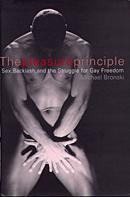
Gay/Lesbian/Feminist Bookstores Around the Country
The Mostly Unfabulous Homepage of Ethan Green
![]()


The Gay Ghetto and the Creation of Culture
From Chapter 11 of The Pleasure Principle
[Editor's Note: The struggle for gay people to gain full citizenship
and social freedom is a complicated process but one that can only happen
when gay and lesbian sexuality and sexual behavior is allowed to flourish
and be visible. Even though it has been thirty years since the Stonewall
riots gay people are still struggling with the promise that "privacy"
will lead to freedom.]
The gay visibility that emerged after the Stonewall riots was a relief
from the enforced privacy of the pre-Stonewall years. Gay people insisted
that they would no longer be invisible. But while it was more possible
for gay people to fight discrimination from their new position of visibility,
the visibility itself did not guarantee acceptance. Often the overt presence
of homosexuality and more public displays of gay culture engendered a
backlash intended to reinforce the closet. This backlash continues today.
Visibility is the ability to be seen, observed, detected; while the decision to become visible is active, being visible is essentially a passive stance. Being visible is very different from being "public." Historically, for an individual or group to be public meant that they were an integral part of the life of the state -- the res publica . This public status entitled the individual to the rights and responsibilities of citizenship. Citizens were expected to partake in public discourse in a full and open manner, and their opinions and lives were treated with respect, which included their not being harassed or abused. In short, they were essential and indispensable members of the body politic.
In the United States gay people are more visible today than ever before, but they are not allowed to be public. They are denied full rights of citizenship, such as the right to marry and to join the military. In thirty-nine states, it is still permissible to discriminate against homosexuals in housing and the workplace; there is no federal law that prevents or redresses discrimination against homosexuals. The Supreme Court has ruled there is no constitutional right to privacy for homosexual sexual activity. In addition, gay men and lesbians frequently are verbally and physically harassed and intimidated. Most journalists and politicians view gay people's opinions as morally suspect or politically limited, or, at best, special pleading.
Increased visibility for gay people has not ensured for them full rights of citizenship--the right to be "public"--or the social context of safety and respect in which to express themselves fully. Visibility for gay people immediately reinforces their stigmatization by identifying them as gay people. By remaining in the closet, gay people can more fully participate as citizens. The irony is that gay people can be public -- treated as full citizens -- as long as they are not visible as gay people.
For gay people to be truly public, they would have to be able to display their sexual orientation and discuss their sexuality within the same parameters laid out for heterosexuals. Even if antigay discrimination and harassment were eliminated, gay people would still not be truly public until they were allowed to be as open about their sexuality as heterosexuals. Until gay sexuality is removed from the realm of "privacy," gay people will never be full citizens.
Complete freedom of expression for gay sexuality is the keystone of gay freedom, for it is homosexual sexual activity that makes gay people different. This sexual otherness is at the root of mainstream culture's deep-seated anxiety about homosexuality and its demand that homosexual visibility be regulated by enforcing the closet.
As gay people demanded increasing visibility, mainstream culture responded by creating small exceptions to the closet, social spaces of sanctioned gay visibility. Often these were unspoken truces involving specific social space. It was possible, for example, for gay people to be more visible or honest about their sexuality in certain professions, such as theater or the arts. However, it was equally important for gay people to find material space in the physical world. It would be in this space that they might not only be "visible," but also find the security and the potential social power to become "public" as well. The homosexual demand for visibility and mainstream culture's constant response of regulation manifested themselves in the material world of space and bodies in the formation of the gay ghetto.
One of the defining moments in European and U.S. history was the enormous population shift from the rural to the urban that began in the early eighteenth century. This occurred in concert with a move from an agrarian to an industrialized economy, the decline of the biological family as the primary focus of self-identification, the rise of individual identity, and the separation of sexual activity from reproduction. Cities grew as people moved there to find work and an independent life away from their biological families. The rise of urban life promoted the formation of new cultures, including a visible gay and lesbian culture.
The blooming of gay public spaces in urban areas occurred, to a large extent, because the population density of cities ensured a higher percentage of self-identified gay people. As early as 1730, London had clearly defined meeting and cruising places for gay men. As gay communities continued to emerge, gay people found myriad ways to be simultaneously visible and hidden within a complex cityscape. The emergence of public, if not always completely visible, gay space was very important because it encouraged the continued formation of a social community. As important, because only the middle and upper-middle classes had access to private space for socializing, gay use of public space included, and was often defined by, the presence of lower-income and working people. This phenomenon reoccurred continually over the next two centuries.
More from The Pleasure Principle:
- Introduction: Attacks on popular culture have everything to do with the modern gay rights movement.
- Suffer the Little Children: Pee-Wee Herman made so many adults uncomfortable, they were glad when his creator was arrested.
- The Eroticized Male Body: With the rise of gay culture came the idea that men could be sexy too.
- Online Exclusive: Pleasure Wars: In this essay, author Michael Bronski traces the thoughts behind this book.

 Back
to the Stonewall Inn
Back
to the Stonewall Inn